
Browse an alphabetical list of photographs. These historical images portray people, places, and events before, during, and after World War II and the Holocaust.
<< Previous | Displaying results 251-300 of 2641 for "Photo" | Next >>
An SS guard watches prisoner laborers at construction work. Neuengamme concentration camp, Germany, wartime.
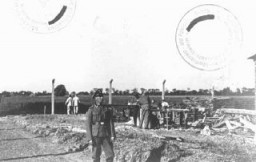
An SS guard speaks with local Ukrainian women while Soviet prisoners of war carry out forced labor. A German Propaganda Company photographer took this image shortly after the SS murdered over 33,000 Jews on September 29-30,1941 at the nearby Babyn Yar killing site. Kyiv (Kiev), German-occupied Soviet Union, after September 30, 1941.
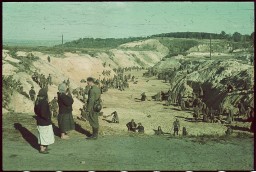
An SS officer stands in front of Jews assembled for deportation. Vienna, Austria, 1941-1942.
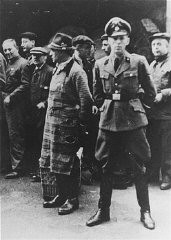
Anna Gutman (Boros) (left) and her daughter, Carla (second from left), visit with Dr. Mohamed Helmy (second from right) and his wife, Emmi (right), in Berlin in 1968. Dr. Helmy hid Gutman in his home for the duration of World War II.
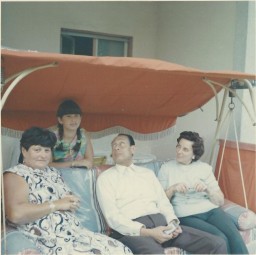
Anna Gutman (Boros) (seated, center), her daughter, and son-in-law visit Dr. Mohamed Helmy (seated, left) and his wife, Emmi (seated, right), in Berlin in 1980. Dr. Helmy hid Gutman in his home for the duration of World War II.
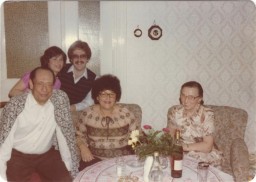
Anne Frank at 11 years of age, two years before going into hiding. Amsterdam, the Netherlands, 1940.
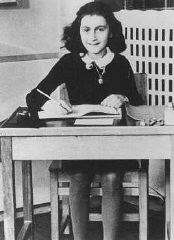
Anne Frank, age twelve, at her school desk. Amsterdam, the Netherlands, 1941.
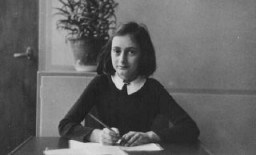
Adolf Hitler and his entourage view a military parade following the annexation of Austria (the Anschluss). Vienna, Austria, March 1938.
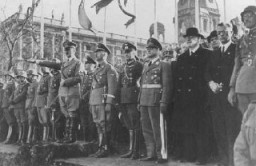
Crowds gathered in the streets of Tel Aviv celebrate the anniversary of the establishment of Israel with an independence day parade. Tel Aviv, Israel, May 1949.
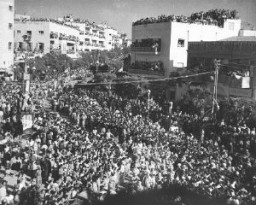
Slovak prime minister Vojtech Tuka (front row, standing) announces Slovakia's entry into the Axis alliance (initially Germany, Italy, and Japan; also joined by Hungary, Romania, and Bulgaria). Berlin, Germany, November 1940.
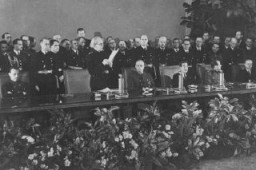
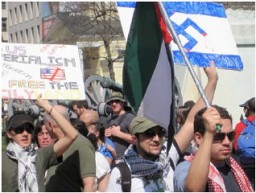
During the anti-Jewish boycott, an SA man stands outside a Jewish-owned store with a sign demanding that Germans not buy from Jews. Berlin, Germany, April 1, 1933.
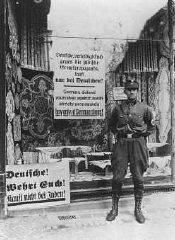
A boycott sign posted on the display window of a Jewish-owned business reads: "Germans defend yourselves against Jewish atrocity propaganda. Buy only at German shops!" Berlin, Germany, April 1, 1933.
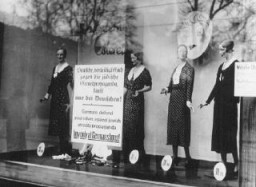
A notice posted by a student group calling for Romanians to protest against the rights of Jews. Iasi, Romania, 1941–1942.
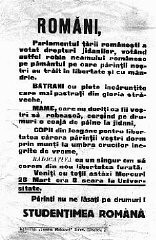
Nazi propaganda cartoon by Seppla (Josef Plank), a political cartoonist. Germany, date uncertain [probably during World War II]. Beginning in the 1920s, Nazi propagandists promoted the antisemitic myth that Jews were engaged in a massive conspiracy to take over the world. This false notion alleged that “international Jewry” used various people and groups as part of a plan for global conquest. At the time, an octopus extending its tentacles over the globe was a common visual metaphor for this…
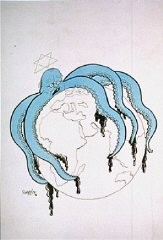
A motorcyclist reads a sign stating "Jews are not welcomed here." Germany, ca. 1935.
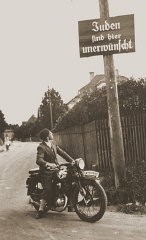
Viennese pedestrians view a large Nazi sign posted on a restaurant window informing the public that this business is run by an organization of the Nazi Party and that Jews are not welcome. Vienna, Austria, March-April 1938.
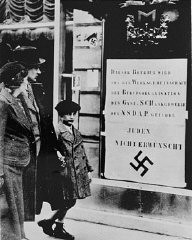
An anti-Jewish sign posted on a street in Bavaria reads "Jews are not wanted here." Julien Bryan took this photograph while visiting Germany in 1937. Back in the United States, Bryan regularly gave lectures with accompanying motion pictures to convey the looming dangers he foresaw in Europe. During one of these presentations in 1938, he said: "And then a sign like this. Along the Rhine you see these signs against the Jew everywhere, … all through central and southern Germany, saying simply and…
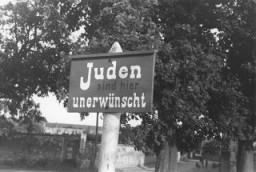
Streetcar in Belgrade bearing the sign: "Forbidden to Jews." Belgrade, Yugoslavia, 1941-1942
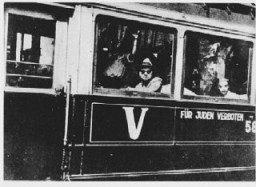
Sign on a phone booth in Munich that prohibits Jews from using the public telephone. Munich, Germany, 1942.
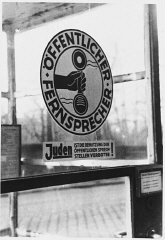
A reconstruction of a Masonic lodge from the Isle of Jersey, on display in an anti-Masonic exhibition in Nuremberg. Germany, 1938.
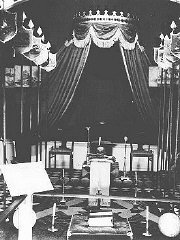
On the day of book burnings in Germany, massive crowds march from New York's Madison Square Garden to protest Nazi oppression and anti-Jewish persecution. New York City, United States, May 10, 1933.
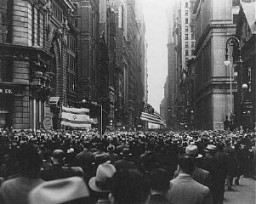
An antisemitic and anti-Masonic display at the exhibition "Der ewige Jude" (The Eternal Jew). The exhibition sought to establish a connection between Jews and Freemasons. Munich, Germany, November 10, 1937.
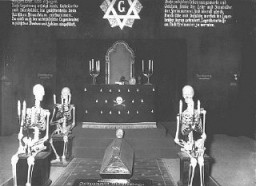
A young man looks at the antisemitic caricature in the display window of the Danzig office of "Der Stürmer." The poster reads: "The Jews are our misfortune." Danzig, 1939.
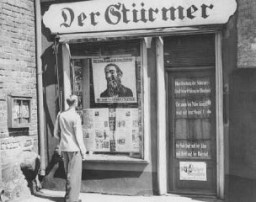
An antisemitic cartoon published in Dr. Kurt Plischke's Der Jude als Rassenschaender: Eine Anklage gegen Juda und eine Mahnung an die deutschen Frauen und Maedchen (The Jew as Race Defiler: An Accusation against Judah and a Warning to German Women and Girls). Germany, ca. 1935.
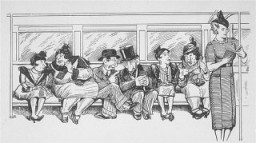
Illustration from a German antisemitic children's book titled Trust No Fox in the Green Meadow and No Jew on his Oath (translation from German). The headlines depicted in the image say "Jews are our misfortune" and "How the Jew cheats." Germany, 1936.
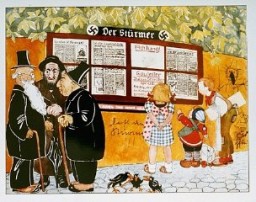
Antisemitic graffiti painted on the wall of a Jewish cemetery reads "The death of the Jews will end the Saarland's distress." Berlin, Germany, November 1938.
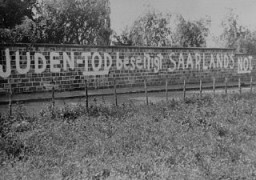
Antisemitic graffiti on a shop window: "The Jewish parasite sold Norway on the 9th of April." April 9 was the day of the German invasion in 1940. Norway, ca. 1940.
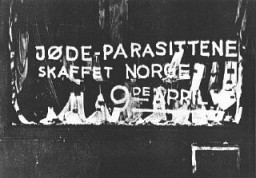
Antisemitic graffiti on Jewish-owned businesses on a Danzig street in 1935. The local Nazi Party had dominated the Danzig Senate since 1933. Danzig, 1935.
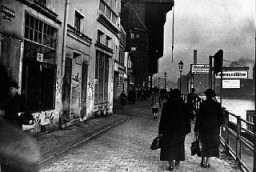
Antisemitic graffiti on a Jewish-owned shop that has been forced to close. Danzig, 1939.
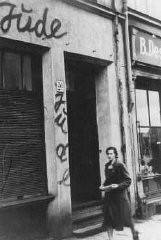
A Jewish-owned cafe in Vienna that was defaced with antisemitic graffiti. Vienna, Austria, November 1938.
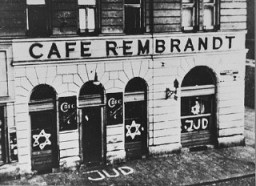
An assortment of antisemitic handbills, posters, and stickers from Germany, 1919.
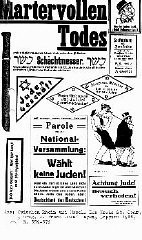
Page of Der Stürmer (The Attacker), a viciously anti-Jewish newspaper published by Julius Streicher. The illustration is an antisemitic photomontage, Germany, 1939. This image was presented as evidence at the Nuremberg trials.
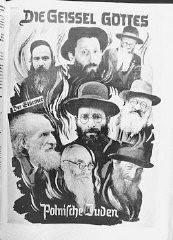
An antisemitic isolationist publication in the United States, ca. 1938–41. It blames Jews and Jewish interests for the war and advocates the boycott of Jewish businesses.

This photo shows a placard urging Hungarian Jews to unite against rising antisemitism in prewar Hungary and Europe. It rallies Jews to protest, using such phrases as: "Protect Jewish honor!”; “Do not buy from our enemies!”; and “Do not watch movies from the Third Reich." Hungary, 1937.
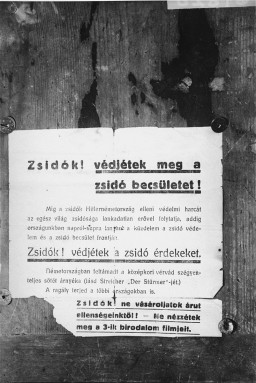
Antisemitic poster equating Jews with communism. The poster calls for the boycotting of Jewish interests. United States, 1939.

An antisemitic poster published in German-occupied Poland in March 1941. The caption reads, "Jews are lice; They cause typhus." This German-published propaganda poster was intended to instill fear of Jews among Christian Poles.
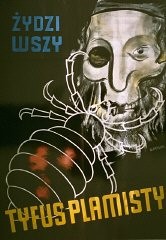
Antisemitic propaganda in the United States that presents President Franklin D. Roosevelt's declaration of a state of unlimited national emergency as the product of an international Jewish conspiracy to save world Jewry and to bring destruction upon America. United States, ca. 1938–41. Among the antisemitic declarations on the caricature are: "Jews Are The Cause of High Taxes - Slavery - Starvation and Death ---" "How long will the American people continue to tolerate this…
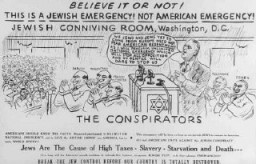
A Jewish man wearing a yellow star reads newly posted antisemitic regulations in Budapest. Hungary, 1944.
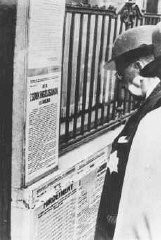
A sign outside a town in northern Bavaria warns: "City of Hersbruck. This lovely city of Hersbruck, this glorious spot of earth, was created only for Germans and not for Jews. Jews are therefore not welcome." Hersbruck, Germany, May 4, 1935.
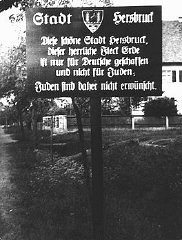
Cover of The Jewish Peril: The Protocols of the Learned Elders of Zion, published in London, 1920. The Protocols of the Elders of Zion is the most notorious and widely distributed antisemitic publication of modern times. Its lies about Jews, which have been repeatedly discredited, continue to circulate today, especially on the Internet.
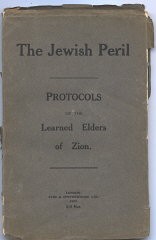
An antisemitic illustration from a Nazi film strip. The caption, translated from German, states: "As an alien race Jews had no civil rights in the middle ages. They had to reside in a restricted section of town, in a ghetto." Place and date uncertain.
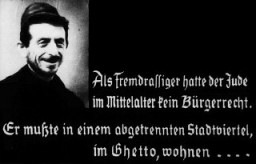
African American athlete Archie Williams competed in the 1936 Berlin Olympic Games. He won the gold medal in the 400-meter race. The US team was the second largest to compete in the 1936 Summer Olympic Games with 312 members, including 18 African Americans.
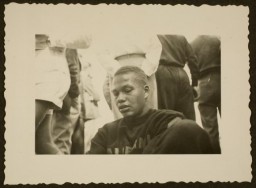
Detail of the 14th Street facade of the United States Holocaust Memorial Museum. Washington, DC, April 2003.
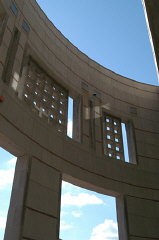
Architectural details in the third floor lounge in the United States Holocaust Memorial Museum.
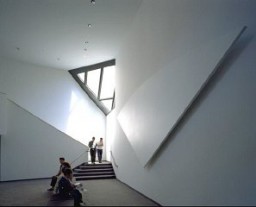
Arie Wilner, a founder of the Warsaw ghetto's Jewish Fighting Organization (ZOB). He was killed in the Warsaw ghetto uprising. Warsaw, Poland, before 1943.
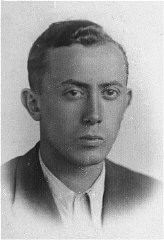
Armenian children lie in the street of an unidentified town. Photograph taken by Armin T. Wegner. Wegner served as a nurse with the German Sanitary Corps. In 1915 and 1916, Wegner traveled throughout the Ottoman Empire and documented atrocities carried out against the Armenians. [Courtesy of Sybil Stevens (daughter of Armin T. Wegner). Wegner Collection, Deutsches Literaturarchiv, Marbach & United States Holocaust Memorial Museum.]
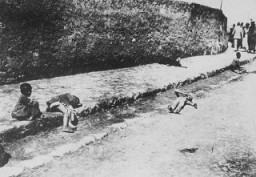
A small group of Armenian deportees walking through the Taurus Mountain region, carrying bundles. A woman in the foreground carries a child. Ottoman Empire, ca. November 1915. Photograph taken by Armin T. Wegner. Wegner served as a nurse with the German Sanitary Corps. In 1915 and 1916, Wegner traveled throughout the Ottoman Empire and documented atrocities carried out against the Armenians. [Courtesy of Sybil Stevens (daughter of Armin T. Wegner). Wegner Collection, Deutsches Literaturarchiv, Marbach…
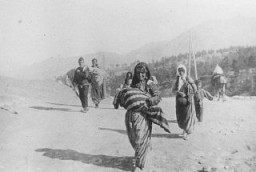
Armenian families next to makeshift tents in a refugee camp. Ottoman Empire, 1915-16.Photograph taken by Armin T. Wegner. Wegner served as a nurse with the German Sanitary Corps. In 1915 and 1916, Wegner traveled throughout the Ottoman Empire and documented atrocities carried out against the Armenians. [Courtesy of Sybil Stevens (daughter of Armin T. Wegner). Wegner Collection, Deutsches Literaturarchiv, Marbach & United States Holocaust Memorial Museum.]
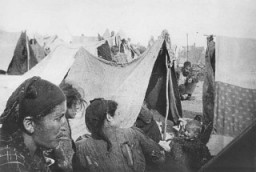
A group of 1,500 Armenian children at a refugee camp of the Near East Relief organization in Alexandroupolis. Greece, 1921–22.
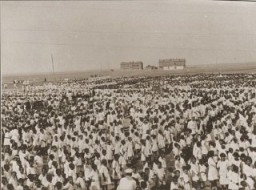
We would like to thank Crown Family Philanthropies, Abe and Ida Cooper Foundation, the Claims Conference, EVZ, and BMF for supporting the ongoing work to create content and resources for the Holocaust Encyclopedia. View the list of donor acknowledgement.